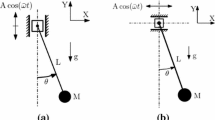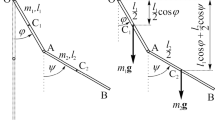Abstract
The regular circular motions of parametrically excited pendula are analyzed via the Multiple Scale Perturbation Method. Two different cases, object of discussions in the literature, are considered, namely the base-excited pendulum (BEP) and the variable-length pendulum (VLP), which exhibit different behaviors, hitherto unexplained. Under the hypothesis that the parametric excitation is of large frequency, the problem is recast in the form of a perturbation of a singular linear differential operator, admitting a double-zero eigenvalue, where the perturbation parameter is identified in the amplitude of the parametric excitation. Similarly to the linear algebraic eigenvalue problem around such a degenerate point, the asymptotic method calls for using fractional power expansions of the perturbation parameter, for both the state variables and the time-derivative operator. However, while the perturbation appears to be regular in the BEP, so that fractional series apply, it is singular in the VLP, so that such expansions degenerate in integer powers. As a consequence, the BEP is more prone to execute circular motions, in the sense that a lower excitation amplitude is required, in comparison with the VLP. Such a result is confirmed by common experiences in the real world, examples of which are given. On the other hand, the VLP admits motions with different angular velocities, while the BEP just admits one velocity, at least to within the order of the asymptotic solution carried out here. The approach followed is believed to give a satisfactory mathematical explanation of the different behaviors of the two systems.







Similar content being viewed by others
Data Availability
The data that support the findings of this study will be made available upon request.
References
Abbas Hassan, S., Osman, T., Khattab, A., Arafa, M., Abdelnaby, M.A.: Design of a self-tunable, variable-length pendulum for harvesting energy from rotational motion. J. Vibroeng. 22(6), 1309–1325 (2020)
Dotti, F.E., Virla, J.N.: Nonlinear dynamics of the parametric pendulum with a view on wave energy harvesting applications. J. Comput. Nonlinear Dyn. 16(6), 061007 (2021)
Alevras, P., Brown, I., Yurchenko, D.: Experimental investigation of a rotating parametric pendulum. Nonlinear Dyn. 81, 201–213 (2015)
Yurchenko, D., Alevras, P.: Parametric pendulum based wave energy converter. Mech. Syst. Signal Process. 99, 504–515 (2018)
Stilling, D.S., Szyszkowski, W.: Controlling angular oscillations through mass reconfiguration: a variable length pendulum case. Int. J. Non-Linear Mech. 37(1), 89–99 (2002)
Reguera, F., Dotti, F.E., Machado, S.P.: Rotation control of a parametrically excited pendulum by adjusting its length. Mech. Res. Commun. 72, 74–80 (2016)
Tusset, A., Janzen, F., Piccirillo, V., Rocha, R., Balthazar, J., Litak, G.: On nonlinear dynamics of a parametrically excited pendulum using both active control and passive rotational (MR) damper. J. Vib. Control 24(9), 1587–1599 (2018)
Stein, A., Parcic, T., Singh, T.: From playground swings to sway control of cranes: an active pendulum experiment. Int. J. Mech. Eng. Ed. (2023). https://doi.org/10.1177/030641902311593
Anderle, M., Appeltans, P., Čelikovskỳ, S., Michiels, W., Vyhlídal, T.: Controlling the variable length pendulum: analysis and Lyapunov based design methods. J. Frankl. Inst. 359(3), 1382–1406 (2022)
Yakubu, G., Olejnik, P., Awrejcewicz, J.: On the modeling and simulation of variable-length pendulum systems: A review. Arch. Comput. Methods Eng. 29(4), 2397–2415 (2022)
Seyranian, A.: The swing: parametric resonance. J. Appl. Math. Mech. 68(5), 757–764 (2004)
Zevin, A., Filonenko, L.: A qualitative investigation of the oscillations of a pendulum with a periodically varying length and a mathematical model of a swing. J. Appl. Math. Mech. 71(6), 892–904 (2007)
Pinsky, M., Zevin, A.: Oscillations of a pendulum with a periodically varying length and a model of swing. Int. J Non-linear Mech. 34(1), 105–109 (1999)
Aslanov, V.S.: Stability of a pendulum with a moving mass: the averaging method. J. Sound Vib. 445, 261–269 (2019)
Yang, H., Han, X.: Existence of periodic solutions for the forced pendulum equations of variable length. Qual. Theory of Dyn. Syst. 22(1), 20 (2023)
Belyakov, A.O., Seyranian, A.P., Luongo, A.: Dynamics of the pendulum with periodically varying length. Phys. D Nonlinear Phenom. 238(16), 1589–1597 (2009)
Wright, J.A., Bartuccelli, M., Gentile, G.: Comparisons between the pendulum with varying length and the pendulum with oscillating support. J. Math. Anal. Appl. 449(2), 1684–1707 (2017)
Belyakov, A.O.: On rotational solutions for elliptically excited pendulum. Phys. Lett. A 375(25), 2524–2530 (2011)
Clifford, M., Bishop, S.: Rotating periodic orbits of the parametrically excited pendulum. Phys. Lett. A 201(2–3), 191–196 (1995)
Xu, X., Wiercigroch, M., Cartmell, M.: Rotating orbits of a parametrically-excited pendulum. Chaos Solitons Fractals 23(5), 1537–1548 (2005)
Xu, X., Wiercigroch, M.: Approximate analytical solutions for oscillatory and rotational motion of a parametric pendulum. Nonlinear Dyn. 47, 311–320 (2007)
Lenci, S., Pavlovskaia, E., Rega, G., Wiercigroch, M.: Rotating solutions and stability of parametric pendulum by perturbation method. J. Sound Vib. 310(1–2), 243–259 (2008)
Luongo, A., Ferretti, M., Di Nino, S.: Stability and Bifurcation of Structures: Statical and Dynamical Systems. Springer, Berlin (2023)
Luongo, A., Paolone, A., Egidio, A.D.: Sensitivities and linear stability analysis around a double-zero eigenvalue. AIAA J. 38(4), 702–710 (2000)
Bogoliubov, N., Mitropolsky, Y.: Asymptotic Methods in the Theory of Nonlinear Oscillations (1961)
Arkhipova, I.M., Luongo, A., Seyranian, A.P.: Vibrational stabilization of the upright statically unstable position of a double pendulum. J. Sound Vib. 331(2), 457–469 (2012)
Arkhipova, I.M., Luongo, A.: Stabilization via parametric excitation of multi-dof statically unstable systems. Commun. Nonlinear Sci. Numer. Simul. 19(10), 3913–3926 (2014)
Thomsen, J.J.: Theories and experiments on the stiffening effect of high-frequency excitation for continuous elastic systems. J. Sound Vib. 260(1), 117–139 (2003)
Thomsen, J.J.: Effective properties of mechanical systems under high-frequency excitation at multiple frequencies. J. Sound Vib. 311(3–5), 1249–1270 (2008)
Shishkina, E., Blekhman, I., Cartmell, M., Gavrilov, S.: Application of the method of direct separation of motions to the parametric stabilization of an elastic wire. Nonlinear Dyn. 54, 313–331 (2008)
Otterbein, S.: Stabilisierung des n-pendels und der indische seiltrick. Arch. Ration. Mech. Anal. 78, 381–393 (1982)
Champneys, A., Fraser, W.: The ‘Indian rope trick’ for a parametrically excited flexible rod: linearized analysis. Proc. R. Soc. Lond. Ser. A Math. Phys. Eng. Sci. 456(1995), 553–570 (2000)
Mullin, T., Champneys, A., Barrie Fraser, W., Galan, J., Acheson, D.: The ‘Indian wire trick’ via parametric excitation: a comparison between theory and experiment. Proc. R. Soc. Lond. Ser. A Math. Phys. Eng. Sci. 459(2031), 539–546 (2003)
Blekhman, I.: Selected Topics in Vibrational Mechanics, vol. 11. World scientific, Singapore (2004)
Galan, J., Fraser, W., Acheson, D., Champneys, A.: The parametrically excited upside-down rod: an elastic jointed pendulum model. J. Sound Vib. 280(1–2), 359–377 (2005)
Nayfeh, A.: Perturbation Methods. Wiley, New York (1973)
Luongo, A., Di Egidio, A., Paolone, A.: Multiple-timescale analysis for bifurcation from a multiple-zero eigenvalue. AIAA J. 41(6), 1143–1150 (2003)
Luongo, A.: On the use of the multiple scale method in solving ‘difficult’bifurcation problems. Math. Mech. Solids 22(5), 988–1004 (2017)
Luongo, A., Di Egidio, A., Paolone, A.: Multiscale analysis of defective multiple-hopf bifurcations. Comput. Struct. 82(31–32), 2705–2722 (2004)
Funding
The authors have not disclosed any funding.
Author information
Authors and Affiliations
Corresponding author
Ethics declarations
Conflict of interest
The authors declare that they have no known competing financial interests or personal relationships that could have appeared to influence the work reported in this paper.
Additional information
Publisher's Note
Springer Nature remains neutral with regard to jurisdictional claims in published maps and institutional affiliations.
Rights and permissions
Springer Nature or its licensor (e.g. a society or other partner) holds exclusive rights to this article under a publishing agreement with the author(s) or other rightsholder(s); author self-archiving of the accepted manuscript version of this article is solely governed by the terms of such publishing agreement and applicable law.
About this article
Cite this article
Luongo, A., Casalotti, A. Asymptotic analysis of circular motions of base- and length-parametrically excited pendula. Nonlinear Dyn 112, 757–773 (2024). https://doi.org/10.1007/s11071-023-09112-3
Received:
Accepted:
Published:
Issue Date:
DOI: https://doi.org/10.1007/s11071-023-09112-3




